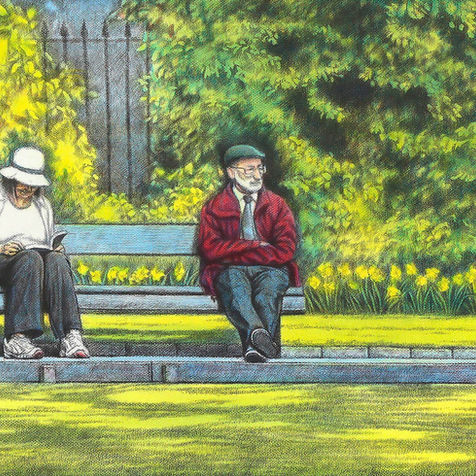
I Wandered...
Rydal Mount, Ambleside
→ 11th April ~ 31th August 2015
The role played by the romantic Poet Laureate William Wordsworth in the conservation of the Lake District ― known as one of the most beautiful areas of the UK ― cannot be underestimated. Wordsworth resisted the move towards modernisation in England, and created masterpieces based on his profound spiritual sense of the beauty of the Lake District. He was also known as a gardener; the vast gardens that he designed and created still remain at Rydal Mount, where the poet spent 37 years of his life, and are famous as one of the last remaining late romantic gardens in the UK. 2015 marks the 200th anniversary of the publication at Rydal Mount of the final version of Wordsworth’s poem “I wandered lonely as a cloud” (also known as “Daffodils”).
This project has been conceived in order to take an artistic approach that crosses the boundaries of time and nationality to link between the pre-modernist Wordsworth and myself as a Japanese artist based in and working out of the postmodern Lake District, taking a contemporary interpretation of the love of nature felt by Wordsworth, and using visual language to present a new body of work. The project is also a collaboration with contemporary poet Gary Boswell, linking modern Britain and Japan through words and pictures in an attempt to extract a more primitive meaning between letters, drawing and painting. The project attempts to take the spirit of romanticism and question its meaning for our current age, in which the acceleration of technology has, to a certain extent, diluted spirituality.
Regarding the diptych portrait of William Wordsworth, I planned from the beginning to place it as the primary work of this exhibition. However, soon after I started it, I found that creating portrait of the historic figure wasn’t easy at all. I researched images after images by various sources but many portraits of him seemed to be too romanticised or too old to refer to. Then I found one in the National Portrait Gallery archives, which was his life mask. Moreover, it was created in 1815 when he was 45, the same year he published the final version of “I Wandered Lonely as a Cloud”. I was thrilled and ecstatic! How could I imagine to find any better likenesses by which I could develop the portrait of this Romantic literary giant for celebrating the 200th anniversary of publication of the poem? My journey began.
The portrait shows almost no other attributes; it features only a ribbon around Wordsworth’s collar, which was a feature of the romantic era. This is because I wanted to draw Wordsworth not so much as a “historical” figure but more as someone of “today”, who challenges the way we live now. By doing this, I hoped to change the way in which Wordsworth is seen as a poet, and his significance to contemporary society. Wordsworth’s dedication as a poet to expressing the importance of the Lake District’s beauty against the wave of industrialization beginning to occur at the time provided the foundations for subsequent movements such as the National Trust, and is still meaningful to us today as environmental problems grow more serious. From that perspective, I believe that Wordsworth was not just a poet, but a prophet, who saw beyond the age in which he lived, just like the Greek and Hebrew poets of ancient history. From that perspective, the lower part of the work, which depicts daffodils, is also highly significant.
Whilst drawing the 45-year old poet, I spent a lot of time thinking about how to express the essence of who he was, beyond the limits of the age in which he lived. I decided to paint the portrait in the diptych style that I have developed over the past few years. The combination of the image of the poet and the image conjured up by the theme “I wandered” – in other words, an endless field of daffodils stretching into black space - was the only way I could find to express the prophetic attributes of Wordsworth across time. The black space connects to the space around the image of the poet, which represents the space and time (more than ten years) it took between Wordsworth originally coming up with the “Daffodils” poem, and arriving at the final version. The lower painting also calls up the daffodils Wordsworth would go on to plant in Dora’s Field after she passed away three years before his own death in 1850, while the portrait hints at the sadness to come from this event. Furthermore, the painting as a whole expresses a view that transcends history, showing us how Wordsworth prophesied the serious environmental problems that we would face in postmodern society. I completed the work in two parts, therefore, with the lower part depicting daffodils and the upper part depicting a portrait of Wordsworth, in order to integrate these attributes.



























